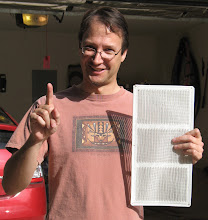For the fun of it, let's compare my energy usage for heating and cooling to the Passivhaus standards. To meet Passivhaus:
- Heating must be less than 15 kWh/square meter per year. Mine is roughly 52.
- Cooling must be less than 15 kWh/square meter per year. Mine is roughly 24.
- Overall energy must be less than 120 kWh/square meter per year. Mine is about 86 (this includes all energy, not just heating and cooling).
- 16-inch thick insulated walls
- incredibly airtight building envelopes
- multipane low-e gas-filled windows
- specially designed air exchange systems
- carefully planned and balanced heat flows
In fact, it seems pretty likely that the overall mildness of the climate here is the main reason that my house falls below the 120 kWh/square meter per year overall energy limit. If there's not all that much heating to be done, and not all that much cooling to be done, it's pretty easy to not spend that much energy even if your house is not all that efficient. That being said, I'm still happy to be under that number (unless my math is wrong... I can post the spreadsheet by popular request).
Another (truly fascinating!) result that I discovered doing this analysis is that I expend far more energy heating during the 3-4 months of relatively mild wintertime than I spend cooling in the 4-5 months of hot, sunny summertime. In fact, despite our long and brutal summers, I spend more than twice as much energy heating the house with the natural gas forced-air heater than I do cooling the house with the air conditioner.
I speculate that this additional expenditure of energy may be due to two factors:
- A large portion of summertime heat gain is through solar radiation hitting the roof, and the radiant barrier now rejects nearly all of that heat, greatly reducing my cooling load. By contrast, winter heat loss is more evenly spread through windows, walls, and ceiling. In my case, I have not improved either the walls or windows, so their relative inefficiency is costing me more in the wintertime.
- In the wintertime, my heater has to more than fully replace the heat that has left the house. Every 1 kWh of heat energy that leaves the house has to be replaced by slightly more than 1 kWh of energy of burned natural gas (due to imperfect efficiency in the burner system). However, in the summertime, I only have to move heat out of the house, which is far more efficient; my 14 SEER air conditioner can move (ideally) 3.7 kWh of heat out of the house by "burning" only 1 kWh of electricity. (See description of COP and SEER here to understand why).
In fact, this brings us back to the coolest (warmest?) feature of the Passivhaus: the internal heat load IS their central heat. These houses are so efficient that, even in frosty places like northern Europe, the internal heat of the occupants and their activities is generally enough to keep the house warm. So in effect, the elimination of central heat (and all the ductwork, grilles, filters, etc. associated therewith) helps to pay for all that added insulation and those nice windows, not to mention the fresh air heat exchanger. Brilliant! The houses still tend to cost more (I've seen numbers from 10% more than "standard" construction, down to as little as 3% more as practices and equipment are standardized). However, such price differences can get paid for pretty quickly, particularly in extreme climates.
Given the particulars of Central Texas, I doubt we will be without air conditioning in our houses anytime soon, especially since even if _all_ external heat were rejected, we'd have to deal with moving internal heat load outside. However, it's within the realm of possibility that central air conditioning might become less common; I have seen new small efficient houses with no central A/C and no ductwork. These are operated with a single wall unit A/C at a roughly central location, typically near the kitchen, and simple air holes placed over interior doors to allow airflow throughout the home. Combined with a high-efficiency heat-exhausting fan at a convenient point in the ceiling (such as a bathroom where you want moisture reduction anyway), these systems apparently work quite well. A small step towards a Passivhaus-type concept, but one in the right direction, and a very affordable one as well.


Conserving energy is a great first step too. The second is making sure your house is built with GREEN in mind. A lot of the renovations will pay for itself in the long run.
ReplyDeleteSplit System AC